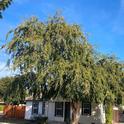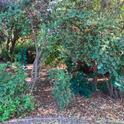
2023 past articles Elinor Teague
Elinor Teague

After writing gardening columns for the Fresno Bee for 18 years, it is a pleasure to be able to continue to offer readers gardening advice and tips here on the Fresno and Madera County Master Gardeners’ website.
Thank you Elinor for your support of the Fresno/Madera Master Gardener programs.
See the 2023 articles below.
-

Winter in the Central Valley garden
A few observations on a rainy day when there's time to check on the winter garden. Many varieties of citrus and other fruit trees have set a bumper crop of small fruit this season. Alternate bearing or the setting of fewer fruit every other year or two is normal for fruiting trees, but this year's bounty of mini fruit is unusual. The cause could be last season's long, cool, wet spring weather that delayed blossom set and pollination. Or it could be that the immature heavy crop of fruit should...
-

Care for landscape trees before winter sets in
Last season's torrential winter rains provided a much-needed relief from 20 years of drought. However, Central Valley home gardeners deal with the effects of drought every summer because, even with regular irrigation, extremely high temperatures during our long, rainless summers create drought stress conditions. Large mature shade-producing landscape trees and bushes have been weakened by years of drought. Summer drought speeds up the normal fall process of slowing vegetative growth and also...
-

Leaves dropped by trees can be an effective garden mulch
The look of neighborhood yards has changed radically these last years. Landscape designs that feature highly-manicured, constantly trimmed, raked, and groomed lawns and planting beds are disappearing, by necessity. Traditional formal plantings (visualize rose beds inside boxwood hedges) are being replaced by drought and heat-tolerant California native and pollinator-friendly plants and trees better suited to our Central Valley climate and better able to survive extreme heat spikes as well as...
-

Take time in September to prepare for future weather extremes
Preparations for severe weather and damage control in home gardens and orchards have become a major focus for Master Gardeners during the last 10 years. California Master Gardeners are helping home gardeners deal with drought, with atmospheric river ‘bombs' that bring high winds, heavy rains and flooding, with heat spikes and with wildfire smoke and ash. This year we also experienced extended cold spells with night time temperatures near freezing until April. Here's a brief review...
July 2023
July 2023 Fresno County MG website column
*file386342*The recent sudden rise in day and nighttime temperatures was a shock to plants that had flourished in cooler-than-average and longer-lasting springtime weather conditions.
The typical summer weather pattern in the Central San Joaquin Valley begins with the formation in late April or early May of a high pressure ridge or dome that traps hot, stagnant air and lowers humidity. This year dangerously high temperatures and dry conditions did not develop until the Fourth of July holiday. Some weather forecasts are anticipating high temperatures with very hot days and nights to be continuous for at least the next two to three months; heat spikes with several consecutive days of extremely high temperatures can also be expected.
Hope for the best; prepare for the worst.’ Central Valley gardeners struggle to mitigate the effects of heat stress, low humidity and air pollution on plants every summer growing season. Some of our practices will need to change or be modified in order to keep plants alive and healthy as overall temperatures rise and weather patterns change. Water conservation is always a concern.
Deep, infrequent irrigation to encourage root development at deeper levels in the soil is still advised during periods of less intense heat. We’ll still need to keep automatic sprinkler systems on the mandated schedule but increase watering times. However, we now need to begin deep irrigation of vulnerable plants several days before heat spikes are predicted to arrive. Use soaker hoses, bubblers on a hose or small oscillating sprinklers to slowly irrigate the soil under the most vulnerable or productive plants to a depth of 8 to 12 inches. Test soil moisture levels frequently with the goal of keeping the soil consistently moist. Most plants will need to be watered in summer when the top inch or two of soil has dried. That maybe a daily or even twice daily occurrence during heat spikes.
Plants that produce crops (fruit and nut trees, summer vegetables, roses) need replacement nutrients as crops are removed. Fruit and nut trees should be fed after harvest with high nitrogen fertilizers. Harvest of fruits and nuts may come sooner than usual as temperatures rise and crops ripen quickly. Summer vegetables are another story. Tomatoes, cucumbers, beans and squashes will stop producing flowers when temperatures are above 90 degrees. Mediterranean varieties of those plants tend to be more heat-tolerant. Heat-loving peppers and eggplants will continue to produce and hold flowers at higher temperatures.
If your plants are holding their flowers and the fruit continues to develop feed lightly with a low-number, low-nitrogen fertilizer once a month. Stop feeding summer vegetables and annual summer-flowering plants if all the flowers or the immature fruit have dropped and resume feeding them when new buds begin to show. Some gardeners continued to put in transplants in May and June, well after the end of the normal summer planting season. The new transplants with immature root systems will be unlikely to survive the first heat spike of July even when well-watered.
June 2023
May 2023 Website Column

The soil is still too wet to plant from seed in some spots leading to further delays in planting this spring. Gardeners have gradually become accustomed to speeding up the spring planting schedule during these last 20 drought years in order to avoid the first heat spikes of the season that became common occurrences in April, rather than in mid to late May (as was the normal pattern during the drought years). Central Valley gardeners have also become accustomed to a very long summer growing season which now begins in March and lasts until mid or even late November. During the driest years with no winter frost and mild temperatures through the winter months some summer annuals simply did not die off and continued to set flowers and fruits. At the end of this April many gardeners are still waiting to harvest their leafy greens and other cool season crops before pulling them out to make room for summer transplants.
This planting season we’ll need to make adjustments to the schedule and to which varieties we plant. Think of the adjustments as an experiment, perhaps keeping a journal or record of planting and harvest times and successes and failures in your garden this year. If next fall and winter are as wet as this last season, the journal will be helpful in planning and in buying seeds and transplants with ripening or bloom times or ‘days to maturity’ that are more suitable for a shorter growing season. Some weather models are predicting higher-than-normal temperatures in late summer and fall this year. We’ll need to search for plant varieties with shorter growing seasons and a high tolerance for hot temperatures-not the easiest combination of attributes to find at the local nurseries or garden centers.
One major and very concerning effect of the long cold, wet spring has been the absence of bees and other pollinators in our spring garden until just this last week. Anecdotal reports (from my neighbor Melissa, the bee keeper) estimate a 30% bee die off this season. It was really spooky to see flowers in full, beautiful bloom with few or no bees actively foraging for pollen. We can only hope that pollinator populations recover soon. Adding a bee count to your garden journal this year can help verify the effect of a really cold wet winter on pollinators.
* SF Chronicle, April 18, 2023
February 2023 MG website column Elinor

January 2023 MG website column Elinor

